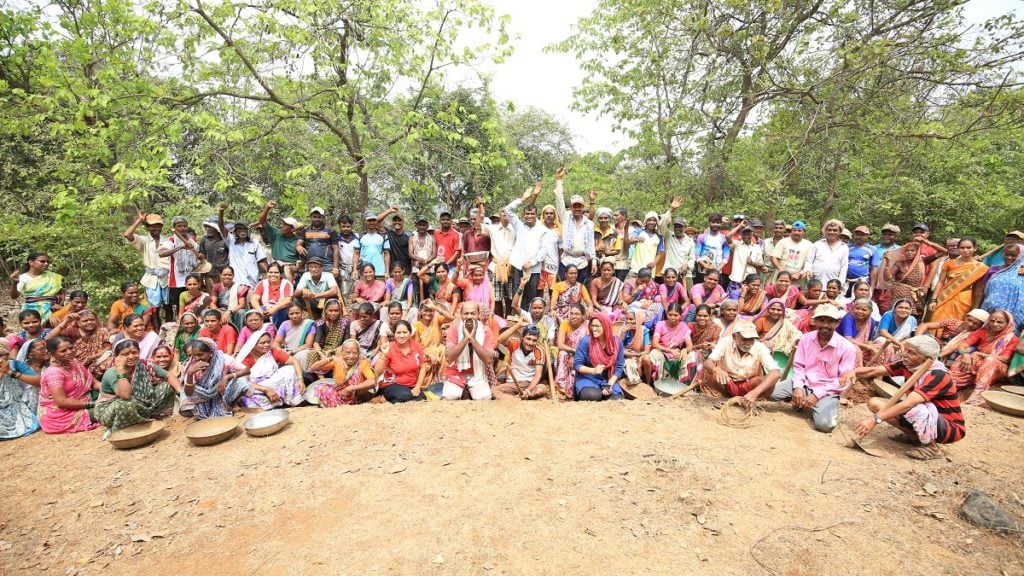Image: Community members from Vihule Kond village in Mangaon block of district Raigad came together for soil conservation
5 min read
Co-Author: Pritha Venkatachalam and Anuja Kadam
There are many names for the value of local knowledge in different spaces. In sports it’s the “home advantage”; in business, the “incumbent’s advantage”; in urban life, it’s “street smarts.” Whatever the name, it’s the idea that lived experience in a place is valuable.
The same is true for the social sector. Over the past decade, there has been growing recognition across the sector that community members’ lived experience matters most: They are uniquely positioned to work with NGOs and funders—or, better yet, to take the lead in solving their own challenges. We call it “community-driven change.”
Over the past few years, we have researched several aspects of community-driven change, and recently published a report on how community-driven change unfolds in urban informal settlements in India and Africa. The study, which draws from case studies of YUVA and CORO in India, and Ubuntu Pathways and SHOFCO in Africa, describes the relationships between community members and local NGOs that work with them. It explores the mindsets the NGOs adopt and the pathways they follow. CORO, for example, treats every woman as a “unit of social change,” and supports them as they form collectives, provides them with fellowships, and clears the way for them to elevate their own voices.
While our study focused on urban settlements, we see the same dynamics in rural settings as well. Consider Swades Foundation, founded by Zarina and Ronnie Screwvala, which aims to empower communities in rural India. Swades works closely with communities with what it calls the “4E model”: Engage, Empower, Execute, and Exit. The model stresses holistic development by “scaling-in,” meaning that it provides multiple solutions for a targeted set of communities, as opposed to expanding a single solution across many geographies.
For example, Swades has worked with local communities across water, irrigation, skilling, livelihoods, education, and health, ensuring that it solves for the most critical vulnerabilities of the community. “And it has gotten results: Some villagers who spent six hours per day to bring water to their homes now have easy access to tap water twice a day; also, many who were invisible and never visited by the local administration or politician now reach out to district and block officers and get their problems addressed,” says Mangesh Wange, CEO of Swades Foundation.
There are five elements to Swades’ approach that would be helpful for other community-driven organisations to consider:
- Through communities’ evolving priorities, Swades listens, learns, and corrects course based on their feedback. In one case, an initiative to enhance the livelihoods of poultry farmers took off only when the responsibility to tend baby chicks shifted to experienced community members.
- Community members highlight that Swades’ flexible approach to understanding community needs and co-creating solutions gives communities more space to innovate, such as trying new crops. They decide priorities, design projects de novo, and are comfortable taking risks. Swades provides technical support and adds expertise when helpful.
- A shared sense of identity strengthens community members’ activities. In several hamlets in Raigad district of Maharashtra, for example, communities wanted to build an image of the village that inculcated a sense of belonging (e.g., painting all homes in a single color, erecting village signage). In another case, in several villages in Raigad district, Swades asked villagers to contribute INR 500 each as a one-time cost to build a solar-powered water reservoir. While this amounted to a small fraction of the actual cost, it gave the community a sense of ownership. Both of those communities found ways to bind themselves together, in one case visually and in the other financially.
- Deep mutual trust brings local assets and capabilities to the fore. Swades has engaged with the same communities over so many years that community members truly trust the foundation, so much so that many young children aspire to work as Swades volunteers in the future. It’s no wonder that many of Swades’ staff have had long-term careers at the foundation and continue to remain invested in the communities they have grown up with.
- Local governance, such as the village development committees (VDCs) that Swades creates, is a vehicle for change. Unlike other rural interventions that engage at the village or Gram Panchayat level, VDCs operate at the hamlet level, given that communities there tend to be more homogeneous in terms of caste. These committees are composed of volunteers, at least 50 percent of whom are women and senior citizens. The committees have their own bank accounts, meet regularly, and follow a robust governance mechanism. Swades provides them training, monitoring, and mentorship.
- Tools and training help to ensure that community-driven change is sustainable from financial, social, and environmental perspectives. Swades apprises community members of their rights, encourages them to work with the government to access existing benefits, and helps them form local governance structures such as the VDCs. Swades also collaborates with communities to design projects keeping climate sustainability in mind (for example, using renewable power in water supply projects).
Swades’ approach has evolved over time, supported by the Screwvalas’ commitment to long-term, unrestricted funding and desire to stay true to impact. Swades now uses a “pull” model for its programs with new hamlets: As community members demonstrate that they can work together, for example, with more than half of a community participating in a cleaning and waste collection project, Swades formally engages with the community and helps it form a VDC. The new VDC identifies government-supported programs that it would like to access and then consults Swades for help only as needed, thus creating a path towards self-governance for communities. Swades defers to communities for decision-making so they can own the change they seek.
Community-driven change is built on local knowledge. But it’s a harbinger of something much bigger. These lessons – inspired by organisations that work closely with communities – are built on fundamentally democratic principles: people coming together to address issues that matter most to them. They’re a small-scale version of what a “living democracy” should look like: people from different communities engaged in constructive dialogue about shared concerns and acting together to improve society.


















